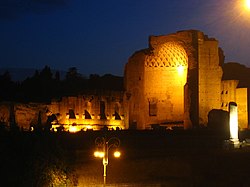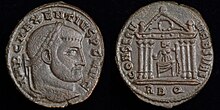Temple of Venus and Roma
Template:Ancient monuments in Rome

The Temple of Venus and Roma Latin: Templum Veneris et Romae is thought to have been the largest temple in Ancient Rome. Located on the Velian Hill, between the eastern edge of the Forum Romanum and the Colosseum, it was dedicated to the goddesses Venus Felix ("Venus the Bringer of Good Fortune") and Roma Aeterna ("Eternal Rome"). The architect was the emperor Hadrian and construction began in 121. It was officially inaugurated by Hadrian in 135, and finished in 141 under Antoninus Pius. Damaged by fire in 307,[1] it was restored with alterations by the emperor Maxentius.
History
In order to build the temple, erected on the remnants of the porticoed vestibule to Emperor Nero's Domus Aurea, the Colossus of Nero was moved and placed near the amphitheatre, which shortly afterwards became known as the Colosseum. Unimpressed by his emperor's architectural skills, Hadrian's most brilliant architect, Apollodorus, made a scornful remark on the size of the seated statues within the cellae, saying that they would surely hurt their heads if they tried to stand up from their thrones. Apollodorus was banished and executed not long after this.[2]
According to the ancient historian Ammianus Marcellinus the temple was among the great buildings of Rome which astonished the Emperor Constantius II on his visit to the city in 357.[3]
Further restoration was performed under Eugenius, a short-lived usurper (392–394) against Theodosius I, whose policy was the restoration of Pagan cults and temples. However, as with many of Rome's majestic ancient buildings the temple was later targeted for its rich materials. In 630 Pope Honorius I with the consent of the Emperor Heraclius, removed the gilt-bronze tiles from the roof of the temple for the adornment of St. Peter's.[4]

A severe earthquake at the beginning of the 9th century is believed to have destroyed the temple. Around 850 Pope Leo IV ordered the building of a new church, Santa Maria Nova, on the ruins of the temple. After a major rebuilding in 1612, this church was renamed Santa Francesca Romana, incorporating Roma's cella as the belltower. A somewhat fanciful vedute engraving by Giovanni Battista Mercati depicts the site in 1629. The vast quantity of marble that once adorned the temple has all but disappeared due to its use as a raw material for building projects from the Middle Ages onwards. The Italian archaeologist Rodolfo Amedeo Lanciani makes reference to his discovery of a lime kiln in close proximity to the temple in his work The Destruction of Ancient Rome.
Presently only a few columns surrounding remain standing in their original positions, while others that have gone missing have been replaced by buxus trees.
Architecture

Set on a platform measuring 145 metres (476 ft) in length and 100 metres (330 ft) in width, and stood 29.5 metres (97 ft) tall, being 31 metres (102 ft) counting the statues, the peristyle (also peripteral) building measured 110 metres (360 ft) in length and 53 metres (174 ft) in width. The temple itself consisted of two main chambers (cellae), each housing a cult statue of a god—Venus, the goddess of love, and Roma, the goddess of Rome, both figures seated on a throne. The cellae were arranged symmetrically back-to-back. Roma's cella faced west, looking out over the Forum Romanum, and Venus' cella faced east, looking out over the Colosseum. A row of four columns (tetrastyle) lined the entrance to each cella, and the temple was bordered by colonnaded entrances ending in staircases that led down to the Colosseum.
The west and east sides of the temple (the short sides) had ten white columns (decastyle), and the south and north (the long sides) featured eighteen white columns. All of these columns measured 1.8 metres (5 ft 11 in) in width, making the temple very imposing.
A reconstruction of the temple interior by German Architect Josef Bühlmann from 1913 depicts two longitudinal colonnades of Corinthian columns forming a central nave flanked by two aisles below a coffered vaulted ceiling. Resting on the columns a double impost forms a double entablature extending back into the exedra, with a cofferred half-dome ceiling above the seated statue. The walls behind the aisles are inset with smaller columns standing some distance above the floor on a plinth. Small statues set in niches between these columns punctuate the walls, the niches surmounted by alternating arched and triangular pediments. More small statues are positioned on the entablature above each small column.
As an additional clever subtlety by Hadrian, Venus also represented love (Amor in Latin), and "AMOR" is "ROMA" spelled backwards. Thus, placing the two divinities of Venus and Rome back-to-back in a single temple created a further symmetry with the back-to-back symmetry of their names as well. Within Venus' cella was another altar where newly wed couples could make sacrifices. Directly adjacent to this altar stood gigantic silver statues of Marcus Aurelius and Faustina the Younger.
Today

Since the papacy of John Paul II, the heights of the temple and its position opposite the main entrance to the Colosseum have been used to good effect as a public address platform. This may be seen in the photograph below where a red canopy has been erected to shelter the Pope as well as an illuminated cross, on the occasion of the Good Friday ceremony. The Pope, either personally or through a representative, leads the faithful through meditations on the stations of the cross while a cross is carried from there to the Colosseum.
The Temple has now been reopened to the public after an extensive restoration programme that lasted 26 years.[5] Access to the temple is included in tickets for the Colosseum, the Forum and the Palatine Hill.
See also
Notes
- ^ Dyson, Stephen L. (2010). Rome : a living portrait of an ancient city. Baltimore: Johns Hopkins University Press. p. 349. ISBN 0-8018-9253-8.
- ^ Cassius Dio, Roman History, 69.4
- ^ Lanciani,Rodolfo Amedeo (1901) The Destruction of Ancient Rome
- ^ Lanciani,Rodolfo Amedeo (1901) The Destruction of Ancient Rome
- ^ http://www.wantedworldwide.net/news/7054/ancient_romes_temple_of_venus_reopens.html
References
- Lorenzatti, Sandro (1990). "Vicende del tempio di Venere e Roma nel Medioevo e nel Rinascimento". Rivista dell’Istituto Nazionale di Archeologia e storia dell’Arte (13): 119–138.
